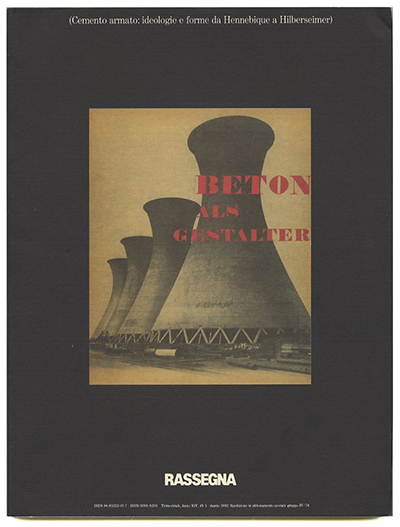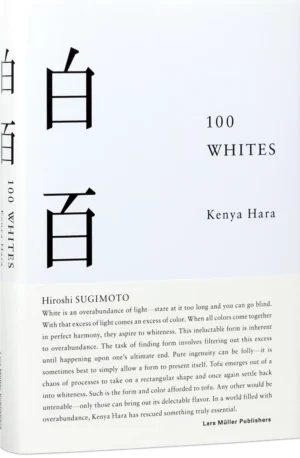RASSEGNA. Problemi di Architettura dell’Ambiente
RASSEGNA 49: CEMENTO ARMATO. Ideologia e Forme da Hennebique a Hilberseimer
INDICE
- Introduction by Luciano Ravanel and Maurice Culot
- The Origins of Reinforced Concrete by Cyrille Simonnet
- Hennebique and Building in Reinforced Concrete Around 1900
- Engineers, Concrete and Companies in Milan at the Turn of the Century by Ornella Selvafolta
- The Philosophers’ Stone: Anatole Baudot and the French Rationalists by Marie-Jeanne Dumont
- Micro-histories of Reinforced Concrete by Marie-Jeanne Dumont
- Material and Modernity by Rejean Legault includes work by Le Corbusier-Saugnier, Freyssinet and Limousin, Antonin Raymond, Gabriel Guevrekian, Perret Bros., Erich Mendelsohn, Max Berg, Jan Visek, Albert Kahn, Giacomo Matte Trucco and Walter Gropius
- The American Discovery of Reinforced Concrete by Jeffrey M. Chusid includes work by Irving Gill, Rudolph Schindler and Frank Lloyd Wright.
- Beyond the Cubic Prison by Anna Maria Zorgno
- The Beauty of Reinforced Concrete by Jacques Gubler
- Advertising section includes work by Renzo Piano [Il Grande Bigo]
Includes work by Le Corbusier-Saugnier, Freyssinet and Limousin, Antonin Raymond, Gabriel Guevrekian, Perret Bros., Erich Mendelsohn, Max Berg, Jan Visek, Albert Kahn, Giacomo Matte Trucco, Walter Gropius, Irving Gill, Rudolph Schindler and Frank Lloyd Wright.
Cover art reproduces the dust jacket of BETON ALS GESTALTER: BAUTEN IN EISENBETON UND IHRE ARCHITEKTONISCHE GESTALTUNG [Stuttgart: Julius Hoffmann, 1928 (Baubucher Band no. 5), by Julius Vischer and Ludwig Hilberseimer].
Under the loose directorship of Vittorio Gregotti, RASSEGNA was an Italian Design magazine underwritten by six Italian firms: Ariston, B&B Italia, Castelli, iGuzzini illuminazione, Molteni and co., and Sabiem. Each issue was devoted to a single designer or theme and lavishly produced, with high-quality reproduction and carefully selected and presented illustrations.
Ludwig Karl Hilberseimer (1885–1967) was a German architect and urban planner best known for his ties to the Bauhaus and to Mies van der Rohe, as well as for his work in urban planning at Armour Institute of Technology (now Illinois Institute of Technology), in Chicago, Illinois.
Hilberseimer studied architecture at the Karlsruhe Technical University from 1906 to 1910. He left before completing a degree. Afterward he worked in the architectural office Behrens and Neumark. Until 1914 he was coworker in the office of Heinz Lassen in Bremen. Later he led the planning office for Zeppelinhallenbau in Berlin Staaken. Beginning in 1919 he was member of the Arbeitsrat für Kunst and November Group, worked as independent architect and town planner and published numerous theoretical writings over art, architecture and town construction.
In 1929 Hilberseimer was hired by Hannes Meyer to teach at the Bauhaus at Dessau, Germany. In July 1933 Hilberseimer and Wassily Kandinsky were the two members of the Bauhaus that the Gestapo identified as problematically left-wing. Like many members of the Bauhaus, he fled Germany for America. He arrived in 1938 to work for Mies van der Rohe in Chicago while heading the department of urban planning at IIT College of Architecture. Hilberseimer also became director of Chicago’s city planning office.
Street hierarchy was first elaborated by Ludwig Hilberseimer in his book City Plan, 1927. Hilberseimer emphasized safety for school-age children to walk to school while increasing the speed of the vehicular circulation system.
Beginning in 1929 at the Bauhaus, Hilberseimer developed studies concerning town construction for the decentralization of large cities. Against the background of the economic and political fall of the Weimar Republic he developed a universal and global adaptable planning system (The new town center, 1944), which planned a gradual dissolution of major cities and a complete penetration of landscape and settlement. He proposed that in order to create a sustainable relationship between humans, industry, and nature, human habitation should be built in a way to secure all people against all disasters and crises.
His most notable built project is Lafayette Park, Detroit, an urban renewal project designed in cooperation with architect Mies van der Rohe and landscape architect Alfred Caldwell.
-
NOTE:
Marzo 1992/Rivista in ottime Condizioni
Potrebbero interessarti anche:
RASSEGNA. Problemi di Architettura dell’Ambiente
RASSEGNA 49: CEMENTO ARMATO. Ideologia e Forme da Hennebique a Hilberseimer
INDICE
- Introduction by Luciano Ravanel and Maurice Culot
- The Origins of Reinforced Concrete by Cyrille Simonnet
- Hennebique and Building in Reinforced Concrete Around 1900
- Engineers, Concrete and Companies in Milan at the Turn of the Century by Ornella Selvafolta
- The Philosophers’ Stone: Anatole Baudot and the French Rationalists by Marie-Jeanne Dumont
- Micro-histories of Reinforced Concrete by Marie-Jeanne Dumont
- Material and Modernity by Rejean Legault includes work by Le Corbusier-Saugnier, Freyssinet and Limousin, Antonin Raymond, Gabriel Guevrekian, Perret Bros., Erich Mendelsohn, Max Berg, Jan Visek, Albert Kahn, Giacomo Matte Trucco and Walter Gropius
- The American Discovery of Reinforced Concrete by Jeffrey M. Chusid includes work by Irving Gill, Rudolph Schindler and Frank Lloyd Wright.
- Beyond the Cubic Prison by Anna Maria Zorgno
- The Beauty of Reinforced Concrete by Jacques Gubler
- Advertising section includes work by Renzo Piano [Il Grande Bigo]
Includes work by Le Corbusier-Saugnier, Freyssinet and Limousin, Antonin Raymond, Gabriel Guevrekian, Perret Bros., Erich Mendelsohn, Max Berg, Jan Visek, Albert Kahn, Giacomo Matte Trucco, Walter Gropius, Irving Gill, Rudolph Schindler and Frank Lloyd Wright.
Cover art reproduces the dust jacket of BETON ALS GESTALTER: BAUTEN IN EISENBETON UND IHRE ARCHITEKTONISCHE GESTALTUNG [Stuttgart: Julius Hoffmann, 1928 (Baubucher Band no. 5), by Julius Vischer and Ludwig Hilberseimer].
Under the loose directorship of Vittorio Gregotti, RASSEGNA was an Italian Design magazine underwritten by six Italian firms: Ariston, B&B Italia, Castelli, iGuzzini illuminazione, Molteni and co., and Sabiem. Each issue was devoted to a single designer or theme and lavishly produced, with high-quality reproduction and carefully selected and presented illustrations.
Ludwig Karl Hilberseimer (1885–1967) was a German architect and urban planner best known for his ties to the Bauhaus and to Mies van der Rohe, as well as for his work in urban planning at Armour Institute of Technology (now Illinois Institute of Technology), in Chicago, Illinois.
Hilberseimer studied architecture at the Karlsruhe Technical University from 1906 to 1910. He left before completing a degree. Afterward he worked in the architectural office Behrens and Neumark. Until 1914 he was coworker in the office of Heinz Lassen in Bremen. Later he led the planning office for Zeppelinhallenbau in Berlin Staaken. Beginning in 1919 he was member of the Arbeitsrat für Kunst and November Group, worked as independent architect and town planner and published numerous theoretical writings over art, architecture and town construction.
In 1929 Hilberseimer was hired by Hannes Meyer to teach at the Bauhaus at Dessau, Germany. In July 1933 Hilberseimer and Wassily Kandinsky were the two members of the Bauhaus that the Gestapo identified as problematically left-wing. Like many members of the Bauhaus, he fled Germany for America. He arrived in 1938 to work for Mies van der Rohe in Chicago while heading the department of urban planning at IIT College of Architecture. Hilberseimer also became director of Chicago’s city planning office.
Street hierarchy was first elaborated by Ludwig Hilberseimer in his book City Plan, 1927. Hilberseimer emphasized safety for school-age children to walk to school while increasing the speed of the vehicular circulation system.
Beginning in 1929 at the Bauhaus, Hilberseimer developed studies concerning town construction for the decentralization of large cities. Against the background of the economic and political fall of the Weimar Republic he developed a universal and global adaptable planning system (The new town center, 1944), which planned a gradual dissolution of major cities and a complete penetration of landscape and settlement. He proposed that in order to create a sustainable relationship between humans, industry, and nature, human habitation should be built in a way to secure all people against all disasters and crises.
His most notable built project is Lafayette Park, Detroit, an urban renewal project designed in cooperation with architect Mies van der Rohe and landscape architect Alfred Caldwell.
-
NOTE:
Marzo 1992/Rivista in ottime Condizioni
Potrebbero interessarti anche:
Prodotti correlati
-
In Offerta
2G 85: Leopold Banchini
59,00 €Il prezzo originale era: 59,00 €.54,00 €Il prezzo attuale è: 54,00 €. Aggiungi al carrello -
2G 83: Smiljan Radic Houses
63,00 € Aggiungi al carrello -
21st Century Architecture: DESIGNER HOUSES
72,00 € Aggiungi al carrello -
In Offerta
101 HOTEL. Lobbies, Bars & Restaurants
69,00 €Il prezzo originale era: 69,00 €.64,00 €Il prezzo attuale è: 64,00 €. Aggiungi al carrello
FAQ
Leggi le domande frequenti per avere maggiori informazioni sui metodi di pagamento, la spedizione e molto altro
Per acquistare uno o più libri è sufficiente compilare l’apposito modulo al quale si accede dalla scheda di ciascun libro.
Qualora i volumi ordinati non siano tutti immediatamente disponibili, il nostro staff si riserva di contattarti via mail per concordare le modalità di spedizione (A: invio immediato dei volumi presenti a magazzino e successivo invio di quelli mancanti – B. invio unico dopo il ricevimento da parte nostra dei volumi mancanti).
N.B. la fattura deve essere esplicitamente richiesta al momento dell’ordine, comunicando la ragione sociale completa di partita IVA e/o Codice Fiscale e Codice SDI.
Ai sensi dell’Art.5 del relativo Decreto, l’acquirente ha il diritto di recedere dal contratto e restituire i volumi ordinati entro 10 giorni lavorativi, purchè nel medesimo stato in cui li ha ricevuti. Il diritto di recesso dovrà essere esercitato mediante invio di lettera raccomandata A.R. a: LIMOND S.a.s. – via Arnolfo di Cambio 24/A – 37138 Verona (VR) – entro il termine di 10 (dieci) giorni lavorativi dal ricevimento dei volumi.
Tutti i resi dovranno essere autorizzati da Limond S.a.s (tel. +393472455641) con l’assegnazione di un numero di autorizzazione alla resa. Le spese di spedizione saranno interamente a carico del cliente e non si accetteranno pacchi in contrassegno.
Al ricevimento dei volumi, e verificata la loro integrità, Limond S.a.s. provvederà, entro 10 (dieci) giorni, ad accreditare il cliente del valore dei volumi restituiti.
La tempestività nell’evasione dell’ordine è determinata dalla disponibilità della merce ordinata. In caso di immediata disponibilità l’ordine verrà evaso entro 2 giorni lavorativi. Qualora uno o più libri non dovessero essere presenti a magazzino possono essere ordinati su richiesta; il nostro staff informerà il cliente, via mail, circa i tempi necessari per l’evasione dell’ordine.
Pagamento tramite bonifico bancario anticipato alle coordinate comunicate in fase di check-out
I costi di invio (che comprendono imballo e spedizione) per libri e riviste in ITALIA sono i seguenti:
Servizio postale: 3-5 gg (per merce immediatamente disponibile presso il nostro magazzino)
- Spedizioni per acquisti fino a 62,00€: €5,50
- Spedizioni per acquisti fino a 120,00€: €9,50
- Spedizioni per acquisti superiori a 120,00€: Gratuite
Per una quotazione dei costi di invio in EUROPA o per spedizioni internazionali vengono richiesti i seguenti dati:
- Nome/Cognome
- Indirizzo (comprensivo di Codice postale)
- Telefono (meglio se Cellulare)
Alla conferma di accettazione, verranno comunicate coordinate bancarie/account PayPal da utilizzare per il pagamento. Un Una volta ricevuto, verrà evasa la spedizione inoltrando notifica e tracciabiltà.









